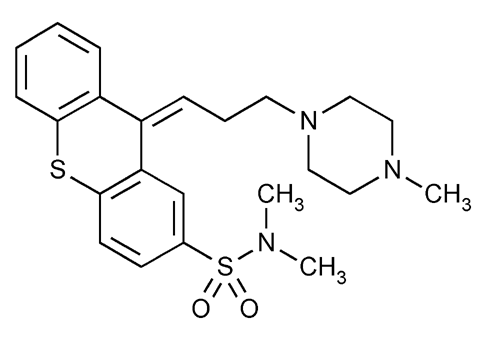Thiothixene
9H-Thioxanthene-2-sulfonamide, N,N-dimethyl-9-[3-(4-methyl-1-piperazinyl)propylidene]-, (Z)-.
N,N-Dimethyl-9-[3-(4-methyl-1-piperazinyl)propylidene]thioxanthene-2-sulfonamide
» Thiothixene contains not less than 96.0 percent and not more than 101.5 percent of C23H29N3O2S2, calculated on the dried basis.
Packaging and storage—
Preserve in tight, light-resistant containers.
Identification—
Solution:
10 µg per mL.
Medium:
methanol.
Absorptivities at about 230 nm and 307 nm, calculated on the dried basis, do not differ by more than 4.0%.
Loss on drying  731
731 —
Dry it in vacuum at 100
—
Dry it in vacuum at 100 for 3 hours: it loses not more than 2.0% of its weight.
for 3 hours: it loses not more than 2.0% of its weight.
Residue on ignition  281
281 :
not more than 0.2%.
:
not more than 0.2%.
Selenium  291
291 :
0.003%.
:
0.003%.
Heavy metals, Method II  231
231 :
0.0025%.
:
0.0025%.
Limit of (E)-thiothixene—
[note—Prepare all solutions in low-actinic glassware.]
Mobile phase—
Transfer 6.9 g of monobasic sodium phosphate to a 1-liter volumetric flask, dissolve in and dilute with deionized water to volume, and mix. Filter through a suitable membrane filter. Mix 4 volumes of this solution with 6 volumes of methanol. The concentration of methanol may be adjusted to meet the system suitability requirements.
Standard preparations—
A—
Using accurately weighed quantities of USP (E)-Thiothixene RS and USP Thiothixene RS, prepare a solution in methanol containing, in each mL, 0.4 mg and 1.2 mg, respectively.
B—
Transfer 5.0 mL of Standard preparation A to a 100-mL volumetric flask, dilute with methanol to volume, and mix.
C—
Transfer about 200 mg of thiothixene, accurately weighed, to a 100-mL volumetric flask. Transfer 5.0 mL of Standard preparation A to the same flask, dissolve in and dilute with methanol to volume, and mix.
Test preparation—
Transfer about 200 mg of Thiothixene, accurately weighed, to a 100-mL volumetric flask. Dissolve in methanol, dilute with methanol to volume, and mix.
Procedure—
Concomitantly introduce equal volumes (about 20 µL) of Standard preparation C and Test preparation into a high-pressure liquid chromatograph operated at room temperature and equipped with a suitable microsyringe or sampling valve, a column containing packing L9 (typically 25 cm × 4.6 mm), an UV detector capable of monitoring absorption at 254 nm, and a suitable recorder. The Mobile phase is maintained at a flow rate of about 1 to 1.5 mL per minute. In a suitable chromatographic system, three replicate injections of Standard preparation B show a resolution factor of not less than 2.2 between the thiothixene and (E)-thiothixene peaks, their retention times being 13 and 15 minutes, and between 16 and 18 minutes, respectively. Calculate the quantity, in mg, of (E)-thiothixene in the portion of Thiothixene taken by the formula:
5CHU / (HC  HU)
HU)
in which C is the concentration of USP (E)-Thiothixene RS, in mg per mL, in Standard preparation A; and HC and HU are the peak responses of the (E)-thiothixene peaks corrected for the tailing of the main peak, obtained from Standard preparation C and the Test preparation, respectively: the limit of (E)-thiothixene is 1.0%.
Assay—
[note—Perform the dilution operations in low-actinic glassware.]
Mobile phase—
Mix 0.5 mL of ethanolamine with 3780 mL of methanol, mix 1400 mL of this solution with 200 mL of water, filter, and degas. Make adjustments if necessary (see System Suitability under Chromatography  621
621 ).
).
Standard preparation—
Using an accurately weighed quantity of USP Thiothixene RS, prepare a solution in methanol having a known concentration of about 0.02 mg per mL.
Assay preparation—
Transfer about 100 mg of Thiothixene, accurately weighed, to a 100-mL volumetric flask, dissolve in and dilute with methanol to volume, and mix. Pipet 2 mL of the resulting solution into a 100-mL volumetric flask, dilute with methanol to volume, and mix.
Chromatographic system
(see Chromatography  621
621 )—The liquid chromatograph is equipped with a 254-nm detector and a 3.9-mm × 30-cm column that contains packing L3. The flow rate is about 0.5 mL per minute. Chromatograph the Standard preparation, and record the peak responses as directed for Procedure: the column efficiency determined from the analyte peak is not less than 2000 theoretical plates, and the relative standard deviation for replicate injections is not more than 1.5%.
)—The liquid chromatograph is equipped with a 254-nm detector and a 3.9-mm × 30-cm column that contains packing L3. The flow rate is about 0.5 mL per minute. Chromatograph the Standard preparation, and record the peak responses as directed for Procedure: the column efficiency determined from the analyte peak is not less than 2000 theoretical plates, and the relative standard deviation for replicate injections is not more than 1.5%.
Procedure—
Separately inject equal volumes (about 20 µL) of the Standard preparation and the Assay preparation into the chromatograph, record the chromatograms, and measure the responses for the major peaks. Calculate the quantity, in mg, of C23H29N3O2S2 in the portion of Thiothixene taken by the formula:
5000C(rU / rS)
in which C is the concentration, in mg per mL, of USP Thiothixene RS in the Standard preparation, and rU and rS are the peak responses obtained from the Assay preparation and the Standard preparation, respectively.
Auxiliary Information—
Please check for your question in the FAQs before contacting USP.
Chromatographic Column—
| Topic/Question | Contact | Expert Committee |
| Monograph | Ravi Ravichandran, Ph.D.
Senior Scientist 1-301-816-8330 |
(MDPP05) Monograph Development-Psychiatrics and Psychoactives |
| Reference Standards | Lili Wang, Technical Services Scientist 1-301-816-8129 RSTech@usp.org |
USP32–NF27 Page 3731
Chromatographic columns text is not derived from, and not part of, USP 32 or NF 27.
